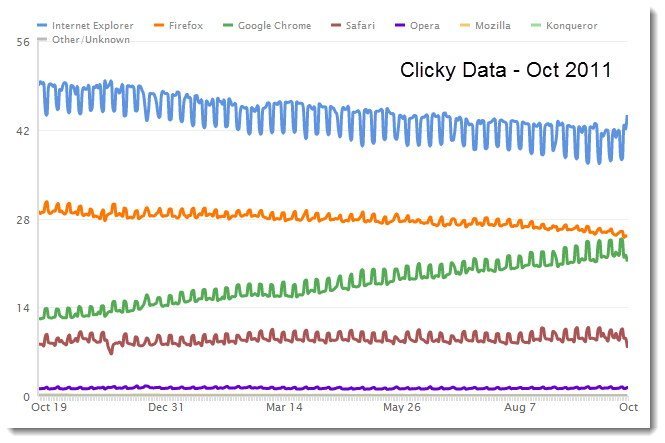The top web browser at this moment, otherwise known as the browser with the most market share online, is easily found using some really handy and freely available tools which I have listed starting a few lines below. That said, why bother?
What is the use of knowing what browsers are the most popular?
Browser compatibility is usually the reason. You see every website created by a developer worth his/her salt will be cross browser compatible at the time it is launched; meaning it will look great on all of the top browsers at that time. The key point here is “it will look great at that time“; as a site gets older Internet technology does not stay the same and browsers are often upgraded which can leave once decent web sites looking lackluster or possibly broken when viewed in the latest browsers. In addition to enhancements in browsers causing problems, you could also be faced with an entirely new browser in the marketplace gaining massive traction (i.e. Google’s Chrome browser) which happens to render your website in ways you never intended.
TIP: If you are creating a business plan and trying to find out what web browser your target market will be using then try viewing the browser data on Quantcast.com for a few websites which closely resemble your anticipated website; you may find other information in the reports helpful as well! Quantcast offers this information free but often times the data is estimated and not the most reliable – in those cases either keep looking for a site that is “Quantified” (logo on footer of page) at which point the data will be highly accurate or settle with the data you have. There are other ways to get this data but I will leave that for another article; contact me if you wish for more details.
CRITICAL NOTE: the data you see here is only relevant if you are considering the masses. In most cases you will want to pay closer attention to your own web site’s analytics reports which will show which browsers are unique to your patrons. Why? Consider the technical aptitude of your visitors. A more technical target market may be customizing their computer more and will have installed Firefox or Chrome whereas a more leisurely and less technical online shopper could stick to the browser that came stock with their Operating System (OS) such as Internet Explorer (Windows) or Safari (Apple).
With the scene set, here is my favourite free site for viewing the latest browser rankings from a myriad of perspectives:
Clicky’s Web Browser Market Share Reports
This data is accrued from over “300 million daily page views across 300,000 + websites using Clicky Analytics“. The following is Clicky’s “Web Browser Top Families” chart which is only one of many available.
Clicky’s 20+ reports are easily read and by simply changing the default region from “Global” to any other country in the world all of the reports are updated with completely new geo-specific browser market share data. This is fantastic. For example, here is the same “Top Families” chart when the data is switched from “Global” to “The United Kingdom”; the data shows a dramatically different uptake in Firefox (which grew) versus Chrome in the UK.
Other metrics freely available include “Special Reports” on top mobile platforms like the Apple iPad, the Motorola Droid and the Nexus One. It also outlines browser market share on everything from video game consoles to mobile web browsers.
Other Great Resources)
NetMarketShare’s Browser Share Trend Report
NetMarketShare’s data is “from the browsers of site visitors to our exclusive on-demand network of HitsLink Analytics and SharePost clients. The network includes over 40,000 websites, and spans the globe” says the help page on data collection methodology. It comprises approximately 160 million unique visitors per month. The confusing thing here is I found the browser statistics record shown below says the information is sourced from RealTimeStats.com which belies the data presented above.
NetMarketShare offers different perspectives than Clicky in addition to many of the same reports.
- StatCounter Browser Statistics Report
The data used to create their reports is accumulated from 3 million+ member sites. The only caution I have about StatCounter is that it is a free tool which has, in the past, been used more often on personal sites instead of business sites.




